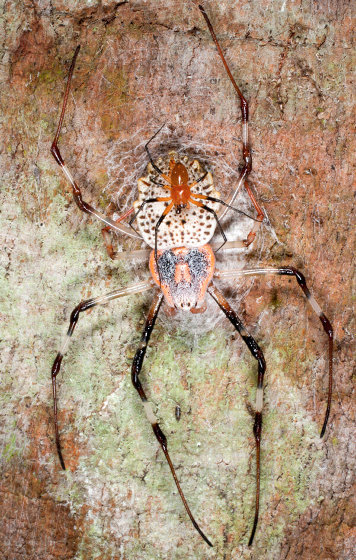Too strange world of 'spider mating'

It is not uncommon for animals to differ in size between males and females, but among them, spiders have a very large size difference, females are 3 to 10 times larger than males, and some species are 10 times longer and 125 times heavier. Due to the overwhelming size difference, mating is crucial for male spiders. Since male spiders are often eaten before, during, and after mating, they have devised various techniques to leave genes for posterity, and the mating is a series of quite strange behaviors from a human perspective. ..
The ungentle joy of spider sex
Male spiders put their sperm into a special net called the 'sperm net' and inhale it with the pedipals that grow near the head. This sperm is preserved until the timing of mating, and the male injects sperm by thrusting the pedipalp into the female to mate. Females also have pedipals near their heads, but females use this structure as legs to catch their prey.
The male has two pedipals and the female has two openings in the abdomen, so the male will try to insert the two pedipals into both openings if possible. Hopefully, sperm will be released from the pedipalp and stored in a sac- like structure called the fertilization sac until the female lays an egg. When a female reaches the stage of laying an egg, sperm are activated and fertilize toward the egg.
Mating seems to be difficult due to the different body sizes of males and females, but this point has become compatible because the female reproductive organs have become smaller and the male reproductive organs have become larger due to evolution. I will. The problem is that the male survives after mating until the female egg is fertilized.

In order to successfully fertilize and retain their genes, male spiders first approach the mating from the back rather than from the front. In addition, males aim for the timing when females have already finished eating and the timing when females have just molted to become adults. A study by zoologist Gabriel Wool of the University of Greifswald in Germany found that a male spider mating with a female with a soft molted exoskeleton has a 97% chance of surviving, while the exoskeleton becomes stiff. It was revealed that the survival probability of males mated with females is reduced to 20%. Female spiders cannot attack until the exoskeleton has hardened.
Female molting occurs so quickly at night that it is difficult to aim for the timing and it is believed that males must observe the female for extended periods of time.
The state of the spider that has just molted is from the following.
Some male spiders bondage female legs. Bondage is not strong enough to immobilize the female, but it is said to have a relaxing effect. Also, when it is judged that danger is imminent, he may cut off his pedipalp and withdraw and leave only the pedipalp in the scalpel.
The behavior of females eating males can be explained biologically reasonably. Females try to mate with multiple males because it is important for females to retain good genes, while males prevent females from mating with other males in order to retain their genes. Because. For this reason, even if a male spider finishes mating without being eaten, it may block the opening of the female by leaving its pedipalp so that the female cannot mate with other males, or fight against a male who came later.
Below is a female opening blocked by a male pedipalp. However, researchers say that the remaining pedipalp may not help at all to prevent another mating.

There are also spiders that try to be eaten by females themselves to ensure fertilization by prolonging mating time as much as possible. The male redback spider brings its abdomen to the female's mouth after the first mating, and when the female begins to eat itself, it inserts a second pedipalp and begins further mating.
On the other hand, male redback spiders and brown widow spiders insert pedipals aiming at females that are not mature and have unexposed openings, block the openings, and succeed in fertilization alive with a higher probability. It is also reported that it is. A Canadian study also shows that one-third of the still immature redback spiders have already mated.
There are a number of biological factors, such as sexual selection and natural selection, that explain why spiders have evolved into such sized differences between sexes and strange mating. For example, the larger the size of a female, the higher the fertility, but if the male becomes larger, the spider web will not be able to bear the weight and it will be easier for predators to target it. There is also the idea that only females have grown.
On the other hand, it has been pointed out that spiders may be extinct due to such an extreme size difference. Larger bodies have their advantages, but small male spiders can invade female nests and steal food, sometimes even eating eggs. Due to the failure of diversification, there is a possibility that 'evolution is facing a dead end' from a long-term perspective.
Related Posts:







